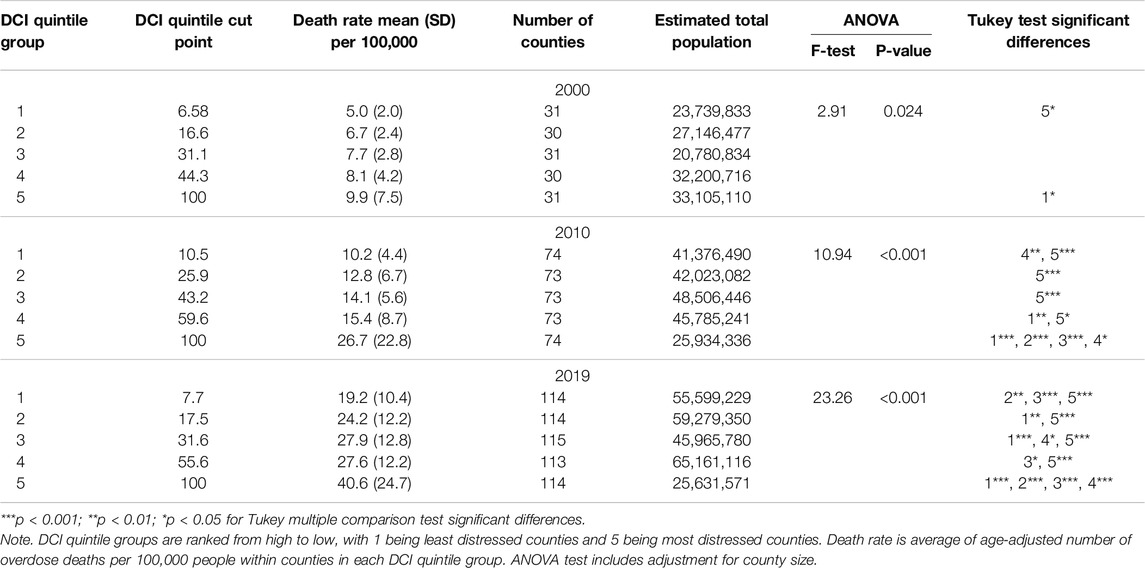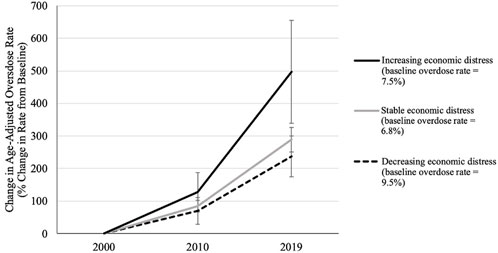- 1Silver School of Social Work, New York University, New York City, NY, United States
- 2Microsoft, Redmond, WA, United States
Introduction
Indices of local economic distress, including local-area unemployment, poverty, low income, and low education, have been linked with lower healthcare quality, higher care costs, and poorer health [1]. There exist vast county-level disparities in economic conditions across the U.S., and counties with greater economic distress demonstrate inequities in health and social determinants of health [2]. Improvements in local economic conditions predict better health including reduced mortality [3] and improved cardiovascular outcomes [4].
The early 2000s saw a reduction in life expectancy, driven by an increase in deaths by drug overdose, suicide, and chronic liver disease [5]. These have been termed “deaths of despair;” while overdose deaths during the early 2000s’ opioid epidemic are attributed to complex factors including overprescribing, there are also likely socioeconomic determinants including distressed local economic conditions [5].
We leveraged two public data sources [the Centers for Disease Control and Prevention’s Wide-ranging Online Data for Epidemiologic Research (CDC WONDER; wonder.cdc.gov) database and the Economic Innovation Group’s Distressed Communities Index (DCI; eig.org/dci-fact-sheet)] to examine whether local economic distress and changes in distress were associated local drug overdose. This approach highlights how public data can be used to explore critical public health questions.
Methods
This study was a secondary data analysis. From CDC WONDER, we obtained U.S. county-level age-adjusted rates of drug overdose deaths per 100,000 people for 2000, 2010, and 2019. Overdose deaths from any psychoactive substance not determined to be a homicide or suicide were included. Counties with less than 20 deaths were excluded because of privacy concerns.
We obtained county-level DCI scores for 2000, 2010, and 2019. DCI scores are constructed by the Economic Innovation Group from seven US Census measures of economic activity, including unemployment, poverty, education, median income, housing vacancy, changes in employment, and changes in business establishments. DCI scores range from 0 (lowest) to 100 (highest economic distress). In contrast to individual indicators of economic distress, this composite measure was designed to be comprehensive and normalized, and it has been linked with mortality outcomes across several domains including due to surgeries and firearms [6, 7].
For cross-sectional analyses, we grouped counties into DCI quintiles and used population-weighted ANOVA to compare overdose deaths between groups, in line with prior work [1, 8]. For longitudinal analyses, we identified counties with overdose death data at both 2000 and 2019 with a DCI score increase (n = 13) or decrease (n = 31) of greater than 10 points, and those that did not experience changes (n = 109). As DCI scores are percentile scores reflecting the distribution of distress across all US counties, a 10-point change represents a meaningful shift in relative economic distress at the county level while also providing large enough sample bins for our analyses. We used population-weighted, repeated measures ANOVA to compare percent change in overdose death rates between DCI change groups. We used Stata version 16 for analyses.
Data were from public sources; IRB approval was not required.
Results
As deaths generally increased during the study period, the number of counties that were included in the sample (with greater than 20 deaths) increased from 2000 to 2019. In 2000, 153 counties representing 136,972,970 individuals were included; the average age adjusted death rate across all counties was 7.46 (SD = 4.52). In 2010, 367 counties representing 203,625,595 individuals were included; the age adjusted death rate was 15.86 (SD = 13.06). In 2019, 570 counties representing 251,637,046 individuals were included; the age adjusted death rate was 27.91 (SD = 16.82).
In cross sectional analyses, age-adjusted overdose death rates were consistently progressively higher in more economically distressed quintile groups, with only one exception when comparing quintiles 3 and 4 in 2019; there were significant differences between groups (F = 2.91, p = 0.024 for 2000; F = 10.94, p < 0.001 for 2010; F = 2019, p < 0.001 for 2019). Table 1 shows mean overdose death rates and ANOVA results for DCI quintile groups in each year. Death rates increased from 2000 to 2019, as did the number of significant differences between DCI quintile groups per post hoc Tukey tests.

Table 1. Age-adjusted death rates means and comparisons between Distressed Communities Index (DCI) quintile groups in 2000, 2010, and 2019 (United States, 2024).
While all DCI change categories evidenced increases in overdose deaths from 2000 to 2019, there was a significant time by category interaction (F = 4.70, p < 0.001). Counties that became more economically distressed (a DCI increase of greater than 10) experienced a five-fold increase in age-adjusted overdose deaths. In contrast, counties with unchanging levels of economic distress experienced a 2.9-fold increase, and counties becoming less economically distressed (a DCI decrease of greater than 10) saw a 2.4-fold increase in overdose deaths. Figure 1 depicts percent change in overdose death rate for counties with and without DCI score changes.

Figure 1. Mean and standard deviation of percent change in age-adjusted overdose death rate by Distressed Communities Index (DCI) change category (United States, 2024). Note. Between 2000 and 2019, “decreasing economic distress” counties’ DCI scores decreased by at least 10 points (Mean DCI change = −18.25; SD = 8.26); “increasing economic distress” counties’ DCI scores increased by at least 10 (Mean DCI change = 17.48; SD = 6.21); and “stable economic distress” counties’ DCI scores changed by less than 10 points (Mean DCI change = −0.78; SD = 4.31). Baseline percent values in the legend indicate raw age-adjusted death rate in 2000 in each group.
As a sensitivity check, we re-ran analyses using continuous DCI scores rather than quintile groupings and included county-level race/ethnicity as a covariate. Results mirrored the original analyses (see Supplementary Material).
Discussion
Worse economic distress was associated with higher drug overdose deaths at the county level between 2000 and 2019. While overdose deaths increased generally over time, counties with worsening distress experienced greater increases in overdose deaths than counties with stable economic distress; improvements in economic distress appeared protective.
Our study aligns with another reporting links between economic distress and deaths of despair [9]. We extend this work by linking a validated measure of county economic distress (the DCI) with a specific outcome (drug overdose deaths). Results suggest local economic policy might impact population health including drug overdose [8].
Our study has several limitations. We only had data on overdose deaths for larger counties, limiting generalizability to smaller counties. Although our quasi-experimental approach strengthens the case for causality, we could not directly evaluate the relationship between local economic conditions and individual-level health outcomes. Our analysis include the pre-COVID 2000–2019 period; results might differ in other periods.
Conclusion
This study exemplifies how leveraging and combining publicly available data can advance public health knowledge. We demonstrate a strong association between local economic distress (and changes in distress) and drug overdose. We highlight the potential health returns of local economic investment particularly in reducing overdose. Future research should consider whether specific economic policies can address overdose.
Ethics Statement
Ethical approval was not required for the study involving humans in accordance with the local legislation and institutional requirements. Written informed consent to participate in this study was not required from the participants or the participants’ legal guardians/next of kin in accordance with the national legislation and the institutional requirements.
Author Contributions
SS drafted the manuscript and performed statistical analyses. WW drafted the manuscript, provided methodological supervision, and procured data. JL supervised the study and assisted with drafting and editing the manuscript. All authors contributed to the article and approved the submitted version.
Funding
The author(s) declare that no financial support was received for the research, authorship, and/or publication of this article.
Conflict of Interest
Authors JL and WW were employed by the company Microsoft.
The remaining author declares that they do not have any conflicts of interest.
Generative AI Statement
The author(s) declare that no Generative AI was used in the creation of this manuscript.
Supplementary Material
The Supplementary Material for this article can be found online at: https://www.ssph-journal.org/articles/10.3389/ijph.2025.1607991/full#supplementary-material
References
1. Weeks, WB, Ouayogodé, MHL, and Weinstein, JN. Association Between a Measure of Community Economic Distress and Medicare Patients' Health Care Utilization, Quality, Outcomes, and Costs. J Gen Intern Med (2018) 33:1433–5. doi:10.1007/s11606-018-4478-7
2. Weeks, WB, Chang, JE, Pagán, JA, Aerts, A, Weinstein, JN, and Ferres, JL. An Observational, Sequential Analysis of the Relationship between Local Economic Distress and Inequities in Health Outcomes, Clinical Care, Health Behaviors, and Social Determinants of Health. Int J Equity Health (2023) 22:181. doi:10.1186/s12939-023-01984-6
3. Wallace, HOW, Fikri, K, Weinstein, JN, and Weeks, WB. Improving Economic Conditions Matter for Mortality: Changes in Local Economic Distress Associated with Mortality Among Medicare Fee-For-Service Beneficiaries between 2003 and 2015. J Gen Intern Med (2021) 37:249–51. doi:10.1007/s11606-020-06410-z
4. Khatana, SAM, Venkataramani, AS, Nathan, AS, Dayoub, EJ, Eberly, LA, Kazi, DS, et al. Association between County-Level Change in Economic Prosperity and Change in Cardiovascular Mortality Among Middle-Aged US Adults. Jama (2021) 325:445–53. doi:10.1001/jama.2020.26141
5. Case, A, and Deaton, A. Rising Morbidity and Mortality in Midlife Among White Non-Hispanic Americans in the 21st Century. Proc Natl Acad Sci U S A (2015) 112:15078–83. doi:10.1073/pnas.1518393112
6. Charles, EJ, Mehaffey, JH, Hawkins, RB, Fonner, CE, Yarboro, LT, Quader, MA, et al. Socioeconomic Distressed Communities Index Predicts Risk-Adjusted Mortality after Cardiac Surgery. The Ann Thorac Surg (2019) 107(6):1706–12. doi:10.1016/j.athoracsur.2018.12.022
7. Akinyemi, OA, Weldeslase, TA, Hughes, K, Williams, M, and Cornwell III, EE. The Distressed Communities Index: A Measure of Community-Level Economic Deprivation and Rate of Firearm Injuries in Maryland. The Am Surgeon™ (2023) 89(12):6084–90. doi:10.1177/00031348231191243
8. Weeks, WB, and Weinstein, JN. Economic Prosperity and Cardiovascular Mortality: Further Evidence that All Policy Is Health Policy. Jama (2021) 325:439–40. doi:10.1001/jama.2020.26717
Keywords: distressed communities index, economic distress, area-level, drug overdose, deaths of despair
Citation: Saba SK, Lavista Ferres JM and Weeks WB (2025) Leveraging Public Data: Changes in Local Economic Distress and Drug Overdose Deaths at the County Level, 2000–2019. Int J Public Health 70:1607991. doi: 10.3389/ijph.2025.1607991
Received: 26 September 2024; Accepted: 11 February 2025;
Published: 21 February 2025.
Edited by:
Florencia Borrescio-Higa, Universidad Adolfo Ibañez, ChileCopyright © 2025 Saba, Lavista Ferres and Weeks. This is an open-access article distributed under the terms of the Creative Commons Attribution License (CC BY). The use, distribution or reproduction in other forums is permitted, provided the original author(s) and the copyright owner(s) are credited and that the original publication in this journal is cited, in accordance with accepted academic practice. No use, distribution or reproduction is permitted which does not comply with these terms.
*Correspondence: Shaddy K. Saba, c2tzOTQ5NkBueXUuZWR1
 Shaddy K. Saba
Shaddy K. Saba Juan M. Lavista Ferres2
Juan M. Lavista Ferres2